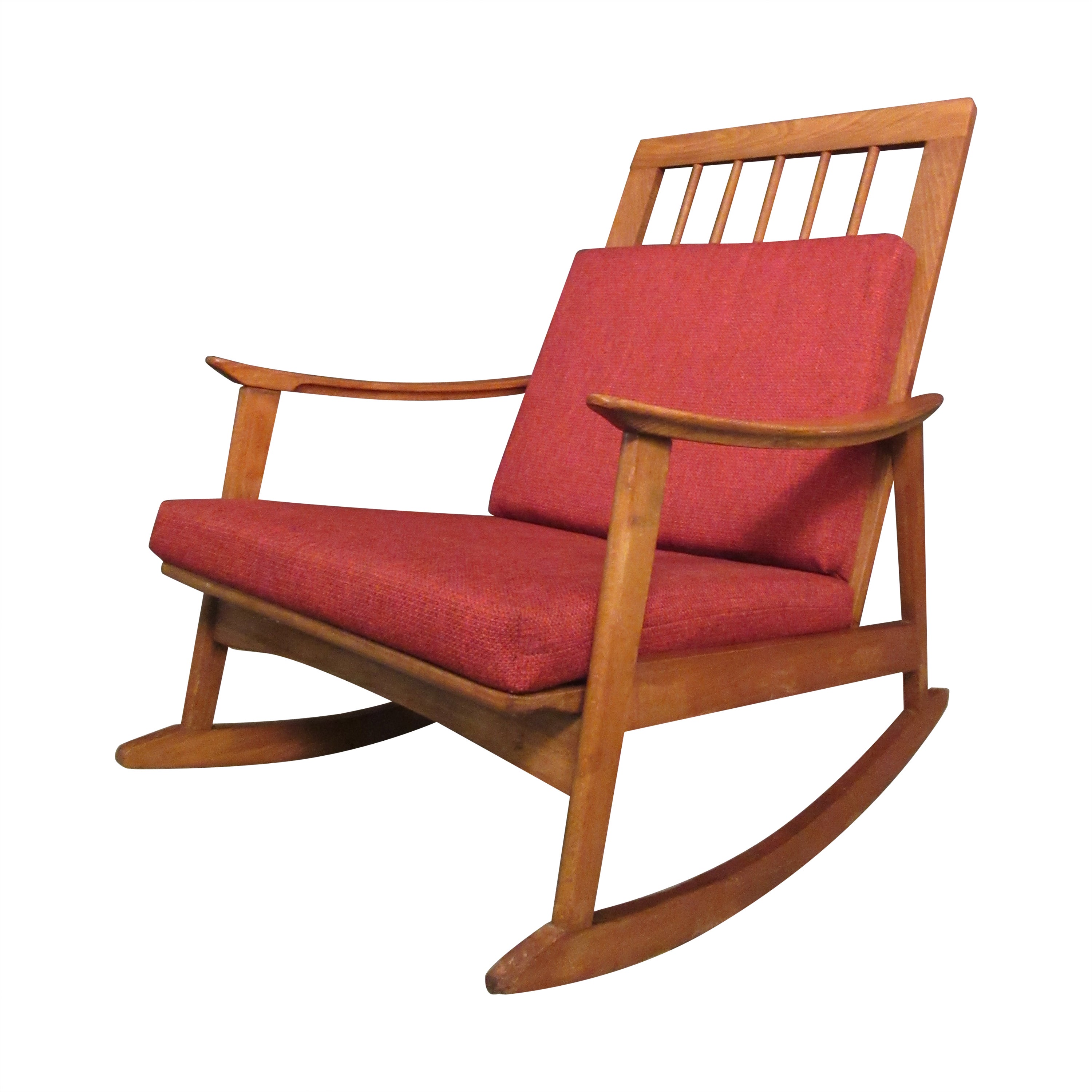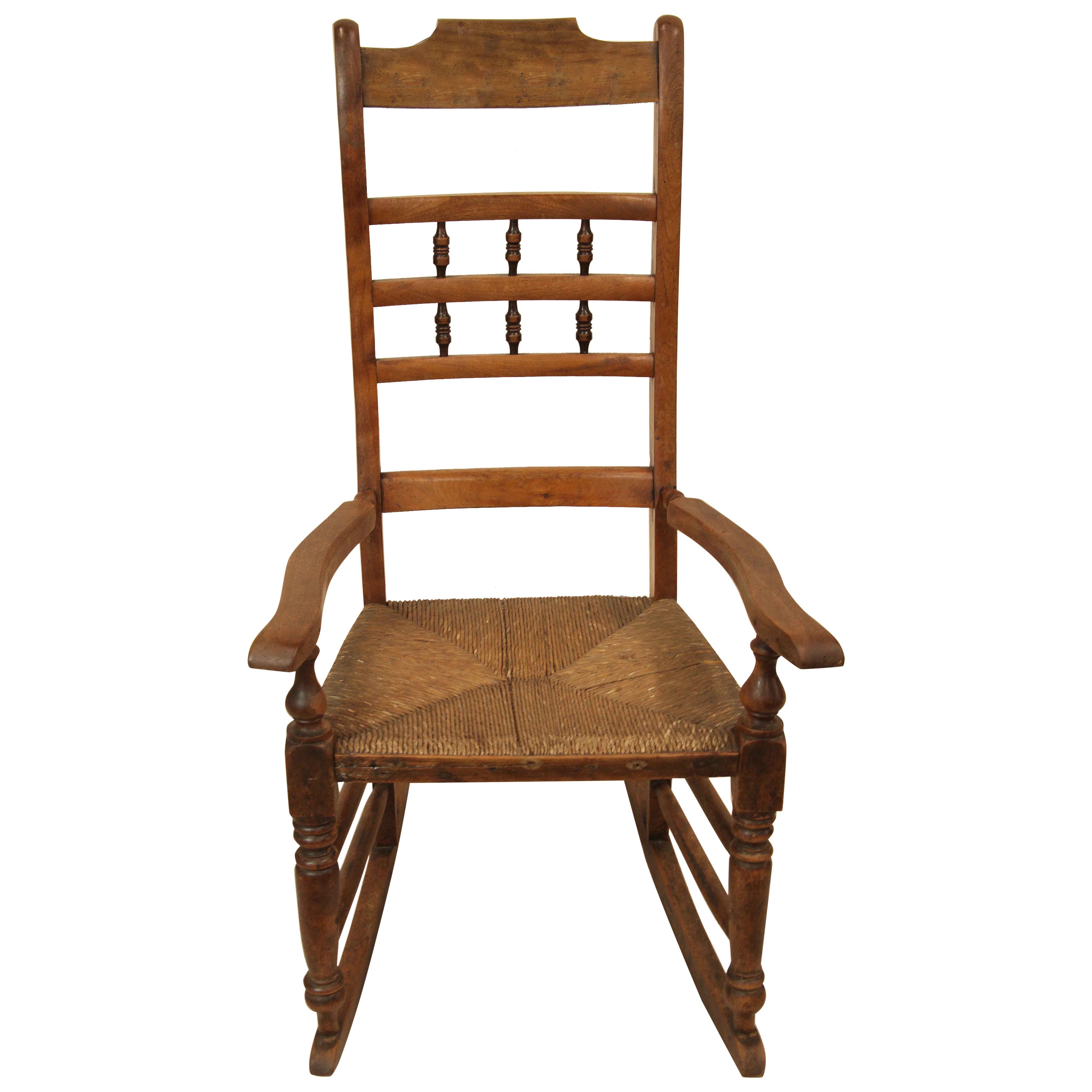Items Similar to Late 19C English Oak Spindle-back Ball Finial Rocker
Want more images or videos?
Request additional images or videos from the seller
1 of 16
Late 19C English Oak Spindle-back Ball Finial Rocker
About the Item
PRESENTING A LOVELY & RARE Late 19C English Oak Spindle-back Ball Finial Rocker.
Probably made in England or Scotland, circa 1880-90.
Made of oak with glorious naturally aged patina.
Turned supports, turned arm rests.
The back splat consists of 3 central spindle sections, separated by a support and each spindle ends in a ball finial on top.
The main back side pillars end in a turned acorn type finial with ball top.
The armrests are serpentine in shape, with spindle side supports, turned front pillars and end with turned round button moldings/medallions.
The base consists of a rocker base with support pillars, the front facing pillars and supports, each being turned.
We initially thought this was an American rocker, but most American rockers were made from pine, walnut, maple etc. and not normally, oak. Although, many Boston Rockers were in fact made of oak, but the style of this one is not like most Boston ones and certainly not the ball finial top section, as most Boston one’s had a solid carved top section often painted with floral motifs.
Oak was the most common wood used in British provincial furniture at that time and with the history of the ‘family ownership’ being based in Canada, with strong roots in both Scotland and England, leads us to believe that this is either an English or Scottish piece.
THIS IS A RARE ROCKER!
WE CANNOT FIND ANOTHER JUST LIKE IT.
IT IS QUITE POSSIBLY, UNIQUE!
Provenance: From a Fine Dallas Estate with roots in Nova Scotia, Canada.
Condition: Very good original condition. Some minor scuffs and nicks through age and use, but nothing significant.
Dimensions: 46 inches tall, 31.5 inches deep and 22.5 inches wide.
Armrest height is 25 inches tall (from the ground)
Seat Height is 15.5 inches, 18.5 inches deep and interior width of 17 inches
Height from seat to top of back is 35 inches.
- Dimensions:Height: 46 in (116.84 cm)Width: 22.5 in (57.15 cm)Depth: 31.5 in (80.01 cm)Seat Height: 15.5 in (39.37 cm)
- Style:Late Victorian (Of the Period)
- Materials and Techniques:
- Place of Origin:
- Period:
- Date of Manufacture:1880-1890
- Condition:Wear consistent with age and use. Very good original condition. Some minor scuffs and nicks through age and use, but nothing significant.
- Seller Location:Dallas, TX
- Reference Number:1stDibs: LU3978134827082
About the Seller
4.9
Platinum Seller
These expertly vetted sellers are 1stDibs' most experienced sellers and are rated highest by our customers.
Established in 2015
1stDibs seller since 2018
349 sales on 1stDibs
Typical response time: <1 hour
- ShippingRetrieving quote...Ships From: Dallas, TX
- Return PolicyA return for this item may be initiated within 7 days of delivery.
More From This SellerView All
- 19C English Rococo Revival Ecclesiastical Oak Hall ChairLocated in Dallas, TXPRESENTING a FABULOUS 19C English Rococo Revival Ecclesiastical Oak Hall Chair. Made in England (Britain) circa 1870 in the Rococo Revival Style from solid oak. The large carved ac...Category
Antique 19th Century English Rococo Revival Chairs
MaterialsOak
- 19C English Naval Captain's Sea ChestLocated in Dallas, TXPRESENTING a GORGEOUS 19C English Naval Captain’s Sea Chest. Made in Britain, probably England, circa 1851-55. Early Victorian Era. Made of...Category
Antique Mid-19th Century English Early Victorian Blanket Chests
MaterialsOak
- 19C English Tunbridgeware Tabletop Stationary Box, Micro MosaicBy Tunbridge WareLocated in Dallas, TXStunning little 19th century tabletop stationary box made of micro-mosaic. Made in Britain, circa 1870, in Tunbridge Wells, hence these type of works are called Tunbridgeware! ...Category
Antique Late 19th Century English High Victorian Decorative Boxes
MaterialsBurl, Boxwood, Ebony, Walnut
- 19C English Chinese Chippendale Mahogany Buffet or SideboardLocated in Dallas, TXPRESENTING A STUNNING AND VERY HIGH QUALITY 19C English Chinese Chippendale Mahogany Buffet or Sideboard. Probably English, unmarked, but ...Category
Antique 19th Century English Chinese Chippendale Sideboards
MaterialsMahogany
- 19C English Marquetry Inlaid Corner Cabinet Attributed to Collinson and LockBy Collinson & LockLocated in Dallas, TXPRESENTING A GORGEOUS late 19th Century British made corner cabinet, made of beautiful rosewood and profusely inlaid with marquetry and faux ivory. Made in London, by Collinson and ...Category
Antique Late 19th Century English High Victorian Corner Cupboards
MaterialsBone, Ebony, Rosewood, Satinwood
- 19C Set of 6 Irish Chippendale Style Ribbon Back Dining ChairsLocated in Dallas, TXPresenting a fabulous 19C set of 6 Irish Chippendale style ribbon back dining chairs. Irish made circa 1840-60. We know that these are Irish due to the signature ‘hairy paw’ feet which is synonymous with Irish Georgian furniture that were made in the Chippendale Style. These are hand crafted chairs, made of mahogany, and have fabulously detailed ‘Ribbon’ backs splats with tassel, acanthus floral and bow details. All 6 have been re-upholstered by us in a gorgeous tan/light gold silk damask fabric which is beautifully sympathetic to the style and period. We are confident that these are Early to Mid 19th Century chairs for a number of reasons: (1) The are hand crafted, (2) the color/patina is what you would expect with natural aging, (3) they have evidence of historic repairs, wear and tear consistent with age, (4) when we removed the old upholstery fabric, which looked like it was done in the 1980’s, we discovered the original ‘horse hair’ cushion filling … this practice stopped in the early 20th Century. The seat webbing was also much older and needed replacing. Fabulous acanthus carving on the knees of the front legs, with curved legs leading down to the fabulously carved hairy paws. Nice indented decoration on the front of the seat. The rear legs are undecorated and curve outwards for additional support and stability. Unsigned and unmarked but undoubtedly made by a top Irish furniture maker. probably in Dublin. Condition: Each chair has been newly re-upholstered and seat webbing replaced. The original horse hair cushion filling was cleaned and incorporated into the new cushion with modern foam to create a more comfortable and uniform seat cushion, but still retaining originality. Each chair has signs of historic repairs to the ribbon back splats over the generations. This is not unusual due to the somewhat delicate nature of these types of back splats. Also, it is an indicator of true age. The chair to the back left in the main photos has had the most repairs and much more recently performed (by us) as the back splaty was broken in 2 places (but we had the original pieces) and the chair needed the insertion of metal pins to secure the repaired sections. We have provided a couple of photos of this back splat which you can see evidence of the repairs. The repairs are very professionally done and the chair is now fully functionable and usable and the repairs are not very noticeable. These repairs are reflected in the pricing, as, if these chairs were ‘mint’ they would be very valuable and expensive ! Irish furniture can be recognised by certain features, which differentiate it from its European counterparts. The Irish style of furniture is said to have been lagging behind in fashion compared to English equivalent by a number of years, in both its design and manner by which the furniture was manufactured. A defining feature of the mid-eighteenth-century furniture is the carving on different parts of the furniture such as the aprons, blanket chests, bottle-stands and such objects. The carvings included foliated details, baskets of flowers and scallop shells, which are some of the most prominent carvings that are represented on Irish furniture at this time. A few of the Irish makers of these objects were James Hicks, Arthur Jones, William Moore, Mack & Gibton and Robert Strahan. All though individuals would have been the most prominent at the time of the 18th century and early 19th century but there are any other cabinet makers as well. Not all Irish furniture was detailed with such wonderful carvings and some might have been seen to be rather plain. One of the most identifiable items that are described as plain is the Irish Hunt Table, its simple elegance comprising of with straight plain legs. It was most commonly used in the dining room of a rural house such as a agents house or large house of a land holder. Another very popular and simply designed piece was the Irish Silver table, its design is very elegant and yet individual partially owing to the shell motive. Other examples of such Irish tables are side tables which have a distinctive double scrolled leg. Usually legs are carved with acanthus and have paw feet which are quite popular in Ireland but more rare in England. Other features are the inside leg which is carved with elongated C-scroll. The triple scroll on the leg was common place. Some cabinet makers and creativity was really captured with their side tables in how the carving was done. This carving may include Jupiters eagle or Lion mask and flanked Swags of flowers. In other furniture such as chairs, the H-shaped serpentine stretcher was popular in the 18th century in Ireland and when English chairs had moved forward in their design the Irish makers were still using the H-shaped serpentine. There was certainly an overlap between Irish and English furniture, one can see that Irish cabinet makers used English pattern books but used Irish features such as the carvings as the shell, baskets of flowers and foliated details. Another unique feature in Irish cabinet making was Killarney ware...Category
Antique Mid-19th Century Irish Chippendale Dining Room Chairs
MaterialsMahogany
You May Also Like
- Mid-Century Modern Oak Spindle Back RockerBy SeligLocated in Brooklyn, NYKick back and relax with the vintage comfort of this mid-century modern oak rocker. The sloping arms and feet gives classic Scandinavian flare into any space. A tall spindle back pea...Category
Mid-20th Century European Mid-Century Modern Rocking Chairs
MaterialsFabric, Oak, Hardwood, Wood, Upholstery
- Antique Late Victorian Carved Quartersawn Oak Barrel Back Rocking Chair RockerLocated in Dayton, OHLate Victorian Rocking Chair. Attributed to Stomps Burkhardt of Dayton, Ohio. Made from quartersawn oak with a heart shaped back, carved and pierced...Category
Antique Late 19th Century Late Victorian Rocking Chairs
MaterialsOak
- Victorian Aesthetic Movement Chestnut Stick & Ball Spindle Rocker Rocking ChairLocated in Philadelphia, PAAntique Victorian Aesthetic Movement Chestnut Stick and Ball Spindle Rocker Rocking Chair. Item features shapely sculpted wood frame, cane seat, uniquel...Category
Antique 19th Century Victorian Rocking Chairs
MaterialsCane, Chestnut
- English Spindle Back Rocking ChairLocated in Wilson, NCEnglish spindle back rocker, this gently rocking chair is very comfortable, having arms and a tall serpentine shaped back. There are two rows of ...Category
Antique 1860s English Rocking Chairs
MaterialsRush, Beech
- Antique Late Victorian Oak Pressback Upholstered Rocking Chair Rocker CameoLocated in Dayton, OHAntique late Victorian pressback rocking chair. A beautiful design featuring a serpentine crest rail with a laurel wreath wrapped cameo at the center featuring a distinguished gentl...Category
Antique Late 19th Century Late Victorian Rocking Chairs
MaterialsUpholstery, Oak
- Russel Wright Spindle Back Rocking Chair for Conant BallBy Russel Wright, Conant BallLocated in Miami, FLSpindle back maple wood rocker designed by Russel Wright and manufactured by Conant Ball.Category
Mid-20th Century American Mid-Century Modern Rocking Chairs
MaterialsMaple
Recently Viewed
View AllMore Ways To Browse
Antique Stickley Rocking Chair
Hitchcock Rocker
Snowshoe Chair
Snowshoe Chairs
St Croix Regency
Stickley Mission Rocker
Stickley Rocker
Vintage Ercol Rocking Chair
Wegner J16 Rocker
Antique Red Leather Rocking Chair
Ingmar Relling Rocker
Isabella Rocking Chair
Oak Rocker Stickley
Sewing Rocking Chair
Stickley Rocking Chair Antique
Vintage Hitchcock Rocking Chair
Vintage Ladder Back Rocking Chair
Yellow North American Rocking Chairs





